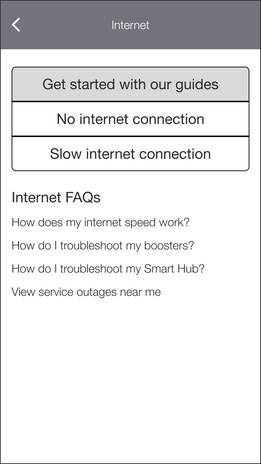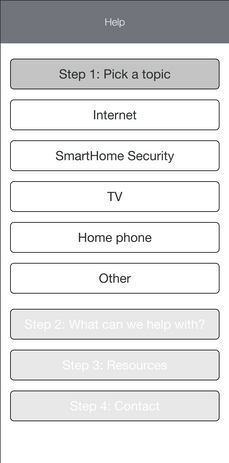TELUS Support
Simplifying Self-Service & Reducing Call Volume
PRODUCT DESIGN LEAD | SELF-SERVICE UX, INTERACTION DESIGN, UX OPTIMIZATION

Imagine you’re a TELUS customer, trying to troubleshoot your internet connection. You turn to self-serve options, but instead of a quick fix, you're met with an overwhelming list of support articles that don’t quite answer your question. Frustrated, you give up and call an agent—only to wait on hold. This was the reality for thousands of customers, leading to rising support costs and a backlog of calls.
My challenge? Redesign the self-service experience to make finding answers seamless and intuitive—reducing the burden on support teams while improving customer satisfaction.
My Role
As one of two designers on this project, I led the refinement of the triaged self-serve support flow, ensuring an intuitive and seamless troubleshooting experience. I designed and conducted A/B tests to evaluate different triage models, collaborated with researchers to analyze usability test data, pinpoint friction points in navigation, and drive design improvements that directly addressed user frustrations. By iterating based on testing insights, we optimized how users found and engaged with troubleshooting resources before escalating to live support.
Challenge
TELUS set a goal for 95% of support requests to start with self-serve, aiming to reduce unnecessary calls and operational costs. However, 87% of users who attempted self-serve still called in, revealing that they struggled to find relevant troubleshooting tools or didn’t trust the process. Many abandoned self-serve out of frustration, leading to high escalation rates.
The challenge was to design a structured flow that made self-serve easier to use and more reliable while ensuring escalation remained available when necessary.
Outcome
To address these issues, I designed and ran A/B tests to evaluate a triaged support model, testing two versions. Testing confirmed that structured troubleshooting improved user interaction with self-serve tools, helping customers resolve issues more efficiently while keeping escalation accessible. Users found troubleshooting content faster, trusted the process more, and escalated to live support less frequently.
Execution
Customers weren’t struggling to search for solutions—they lacked a clear, structured flow that guided them to the right resource. To address this, I designed and ran A/B tests on two versions of the triaged support flow. I oversaw participant testing, where users attempted to troubleshoot a Wi-Fi connectivity issue before escalating to an agent. After synthesizing test results, I identified usability barriers and implemented design refinements to streamline the troubleshooting experience.
Testing confirmed that users engaged more with self-serve when guided through a structured flow that surfaced relevant solutions at the right time. However, trust was equally critical—users needed reassurance that escalation remained an option. I iterated on design refinements based on testing insights, combining the strongest elements from both versions to create an intuitive, reliable, and user-focused troubleshooting experience.
Impact
My contributions to refining the support flow led to a more effective self-serve experience, reducing unnecessary calls and reinforcing customer trust in troubleshooting tools. Customers found answers faster, felt more in control of their troubleshooting experience, and escalated issues less frequently.
By reinforcing trust in self-serve options, the support experience became more efficient and cost-effective. Users no longer viewed self-service as a barrier to speaking with an agent but as a credible first step in resolving their issues.
Reflection + Key Takeaways
Optimizing support isn’t just about improving navigation—it’s about ensuring users trust self-service solutions. This project reinforced the importance of structured troubleshooting flows, intuitive UI design, and continuous user testing in refining digital support experiences. By prioritizing usability and clear escalation pathways, we made self-serve feel like a helpful tool, not a dead-end.
This project wasn’t just about redesigning a support center—it was about restoring confidence in self-service support. By focusing on clarity, guidance, and user empowerment, we created an experience that reduced call volume while giving users the tools to resolve their own problems with ease.

















